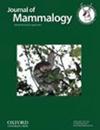栖息地对高纬度地区棕色旅鼠(Lemmus trimucronatus)细尺度空间利用的影响
IF 1.6
3区 生物学
Q2 ZOOLOGY
引用次数: 0
摘要
小型哺乳动物对空间的利用应反映其对食物和捕食者庇护所的直接需求,但也会受到生物和非生物因素季节性变化的影响。旅鼠是苔原食物网的关键物种,但有关其空间分布与生境异质性关系的信息仍然很少,尤其是在精细尺度上。在这项研究中,我们使用空间明确的捕获-再捕获方法来确定地形、水文、植被和土壤特性如何影响棕色旅鼠(Lemmus trimucronatus)夏季密度的细尺度空间变化。整个夏季,我们在潮湿和中度苔原栖息地以及同样位于中度苔原的捕食者排斥网格中对旅鼠进行了监测。我们发现,在潮湿的苔原上,地形崎岖、以驼峰为主的地点旅鼠密度较高,但只有在融雪期间才会出现这种情况。在两个中生苔原地点,排水不畅、地势低洼的地点旅鼠密度在整个夏季都较高。我们发现旅鼠密度与任何测试的植被或土壤变量之间都没有明显的联系。总体而言,水文和地形似乎在棕色旅鼠的小规模空间利用中起着主导作用,而对捕食者的规避和食物植物的丰度则起着次要作用。本文章由计算机程序翻译,如有差异,请以英文原文为准。
Influence of habitat on fine-scale space use by brown lemmings (Lemmus trimucronatus) in the High Arctic
Space use by small mammals should mirror their immediate needs for food and predator shelters but can also be influenced by seasonal changes in biotic and abiotic factors. Lemmings are keystone species of the tundra food web, but information on their spatial distribution in relation to habitat heterogeneity is still scant, especially at a fine scale. In this study, we used spatially explicit capture–recapture methods to determine how topography, hydrology, vegetation, and soil characteristics influence the fine-scale spatial variations in summer density of brown lemmings (Lemmus trimucronatus). Lemmings were monitored throughout the summer in wet and mesic tundra habitats and in a predator exclusion grid, which was also located in mesic tundra. We found that in wet tundra, lemming densities were higher at sites with a rugged topography dominated by hummocks, but only during snow melt. In both mesic tundra sites, lemming densities were higher in sites with poor drainage and low aspect throughout the summer. We found no clear association between lemming densities and any tested vegetation or soil variables. Overall, hydrology and topography appear to play a dominant role in small-scale space use of brown lemmings with a secondary role for predator avoidance and food plant abundance.
求助全文
通过发布文献求助,成功后即可免费获取论文全文。
去求助
来源期刊

Journal of Mammalogy
生物-动物学
CiteScore
3.30
自引率
5.90%
发文量
106
审稿时长
4-8 weeks
期刊介绍:
Papers are published on mammalian behavior, conservation, ecology, genetics, morphology, physiology, and taxonomy.
 求助内容:
求助内容: 应助结果提醒方式:
应助结果提醒方式:


